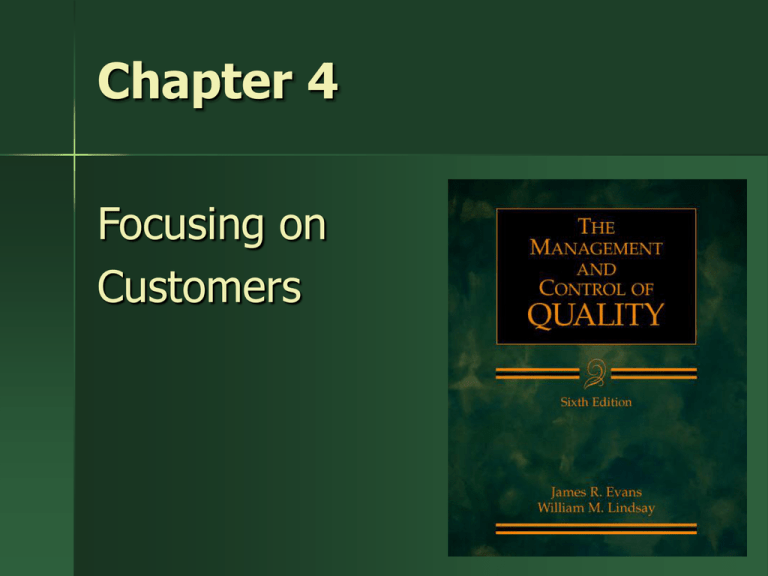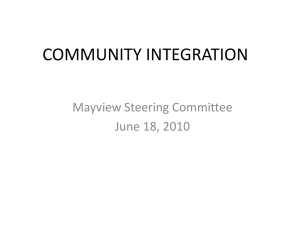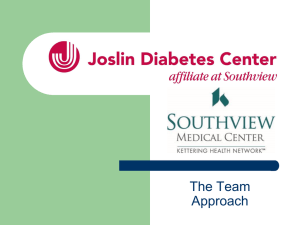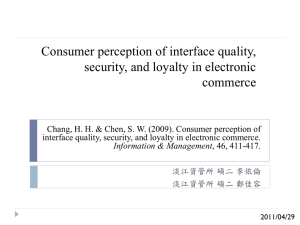Focusing on Customers
advertisement

Chapter 4 Focusing on Customers 1 Key Idea To create satisfied customers, the organization needs to identify customers’ needs, design the production and service systems to meet those needs, and measure the results as the basis for improvement. Importance of Customer Satisfaction and Loyalty “Satisfaction is an attitude; loyalty is a behavior” Loyal customers spend more, are willing to pay higher prices, refer new clients, and are less costly to do business with. It costs five times more to find a new customer than to keep an existing one happy. A firm cannot create loyal customers without first creating satisfied customers. 3 Key Idea Customer wants and needs drive competitive advantage, and statistics show that growth in market share is strongly correlated with customer satisfaction. American Customer Satisfaction Index Measures customer satisfaction at national level Introduced in 1994 by University of Michigan and American Society for Quality Continual decline in index from 1994 through 1998 with a small improvement into 2000 suggests that quality improvements have not kept pace with consumer expectations 5 ACSI Model of Customer Satisfaction Perceived quality Perceived value Customer expectations Customer complaints Customer satisfaction Customer loyalty Key Idea The econometric model used to produce ACSI links customer satisfaction to its determinants: customer expectations, perceived quality, and perceived value. Customer satisfaction, in turn, is linked to customer loyalty, which has an impact on profitability. Customer-Driven Quality Cycle Customer needs and expectations (expected quality) Identification of customer needs Translation into product/service specifications (design quality) Output (actual quality) Customer perceptions (perceived quality) measurement and feedback PERCEIVED QUALITY is a comparison of ACTUAL QUALITY to EXPECTED QUALITY 8 Key Idea Many organizations still focus more on processes and products from an internal perspective, rather than taking the perspective of the external customer. Leading Practices (1 of 2) Define and segment key customer groups and markets Understand the voice of the customer (VOC) Understand linkages between VOC and design, production, and delivery Leading Practices (2 of 2) Build relationships through commitments, provide accessibility to people and information, set service standards, and follow-up on transactions Effective complaint management processes Measure customer satisfaction for improvement Key Customer Groups Organization level – – – – consumers external customers employees society Process level – internal customer units or groups Performer level – individual internal customers Identifying Internal Customers What products or services are produced? Who uses these products and services? Who do employees call, write to, or answer questions for? Who supplies inputs to the process? AT&T Customer-Supplier Model Your Suppliers Inputs Requirements and feedback Your Your Outputs Processes Customers Requirements and feedback 14 Key Idea The natural customer-supplier linkages among individuals, departments, and functions build up the “chain of customers” throughout an organization that connect every individual and function to the external customers and consumers, thus characterizing the organization’s value chain. Customer Segmentation Demographics Geography Volumes Profit potential Key Idea Segmentation allows a company to prioritize customer groups, for instance by considering for each group the benefits of satisfying their requirements and the consequences of failing to satisfy their requirements. Key Dimensions of Quality Performance – primary operating characteristics Features – “bells and whistles” Reliability – probability of operating for specific time and conditions of use Conformance – degree to which characteristics match standards Durability - amount of use before deterioration or replacement Serviceability – speed, courtesy, and competence of repair Aesthetics – look, feel, sound, taste, smell Key Dimensions of Service Quality Reliability – ability to provide what was promised Assurance – knowledge and courtesy of employees and ability to convey trust Tangibles – physical facilities and appearance of personnel Empathy – degree of caring and individual attention Responsiveness – willingness to help customers and provide prompt service 19 Kano Model of Customer Needs Dissatisfiers: expected requirements Satisfiers: expressed requirements Exciters/delighters: unexpected features 20 Key Idea As customers become familiar with them, exciters/delighters become satisfiers over time. Eventually, satisfiers become dissatisfiers. Customer Listening Posts Comment cards and formal surveys Focus groups Direct customer contact Field intelligence Complaint analysis Internet monitoring 22 Key Idea Companies use a variety of methods, or “listening posts,” to collect information about customer needs and expectations, their importance, and customer satisfaction with the company’s performance on these measures. Tools for Classifying Customer Requirements Affinity diagram Tree diagram Moments of Truth Every instance in which a customer comes in contact with an employee of the company. Example (airline) – – – – – – – – Making a reservation Purchasing tickets Checking baggage Boarding a flight Ordering a beverage Requests a magazine Deplanes Picks up baggage Key Idea An organization builds customer loyalty by developing trust, communicating with customers, and effectively managing the interactions and relationships with customers through approaches and its people. Companies must carefully select customer contact employees, train them well, and empower them to meet and exceed customer expectations. Customer Relationship Management Accessibility and commitments Selecting and developing customer contact employees Relevant customer contact requirements Effective complaint management Strategic partnerships and alliances Exploiting CRM technology Key Idea To improve products and processes effectively, companies must do more than simply fix the immediate problem. They need a systematic process for collecting and analyzing complaint data and then using that information for improvements. Measuring Customer Satisfaction Discover customer perceptions of business effectiveness Compare company’s performance relative to competitors Identify areas for improvement Track trends to determine if changes result in improvements 29 Key Idea An effective customer satisfaction measurement system results in reliable information about customer ratings of specific product and service features and about the relationship between these ratings and the customer’s likely future market behavior. Survey Design Identify purpose Determine who should conduct the survey Select the appropriate survey instrument Design questions and response scales Key Idea The types of questions to ask in a survey must be properly worded to achieve actionable results. By actionable, we mean that responses are tied directly to key business processes, so that what needs to be improved is clear; and information can be translated into cost/revenue implications to support the setting of improvement priorities. Performance-Importance Analysis Low Low Performance High Who cares? Overkill Vulnerable Strengths Importance High Key Idea Appropriate customer satisfaction measurement identifies processes that have high impact on satisfaction and distinguishes between low performing processes low performance and those that are performing well. Difficulties with Customer Satisfaction Measurement Poor measurement schemes Failure to identify appropriate quality dimensions Failure to weight dimensions appropriately Lack of comparison with leading competitors Failure to measure potential and former customers Confusing loyalty with satisfaction Customer Perceived Value CPV measures how customers assess benefits—such as product performance, ease of use, or time savings—against costs, such as purchase price,installation cost or time, and so on,in making purchase decisions. Customer and Market Focus in the Baldrige Criteria The Customer and Market Focus category examines how an organization determines requirements, expectations, and preferences of customers and markets; and how it builds relationships with customers and determines the key factors that lead to customer acquisition, satisfaction, loyalty, and retention, and to business expansion. 3.1 Customer and Market Knowledge 3.2 Customer Relationships and Satisfaction a. Customer Relationship Building b. Customer Satisfaction Determination








